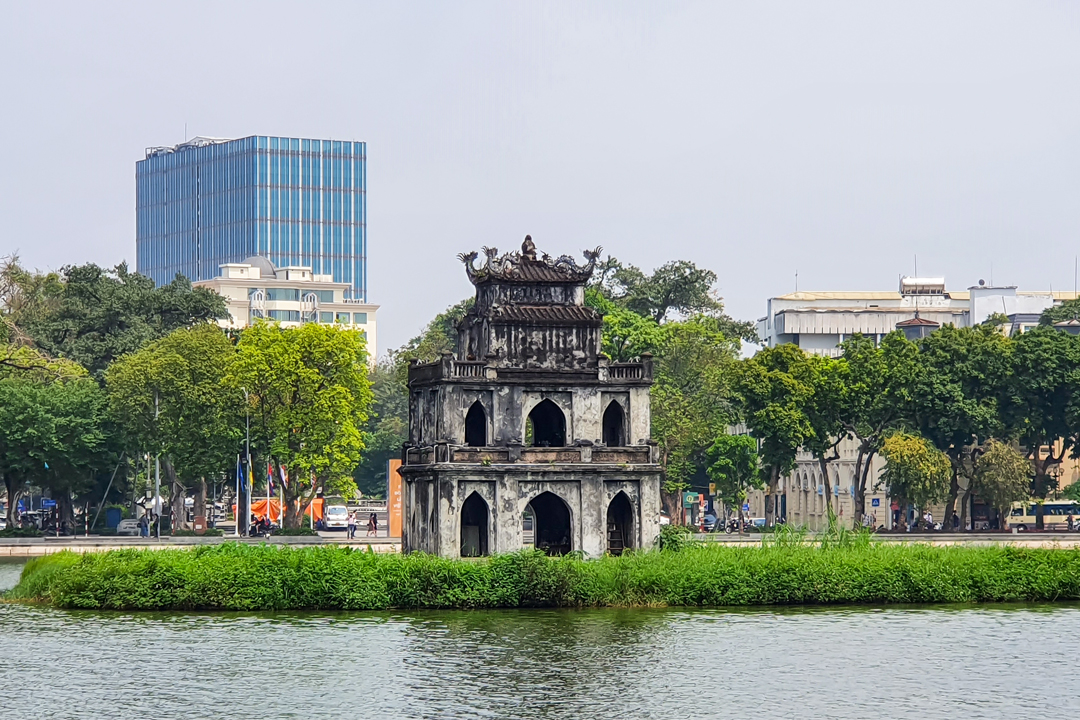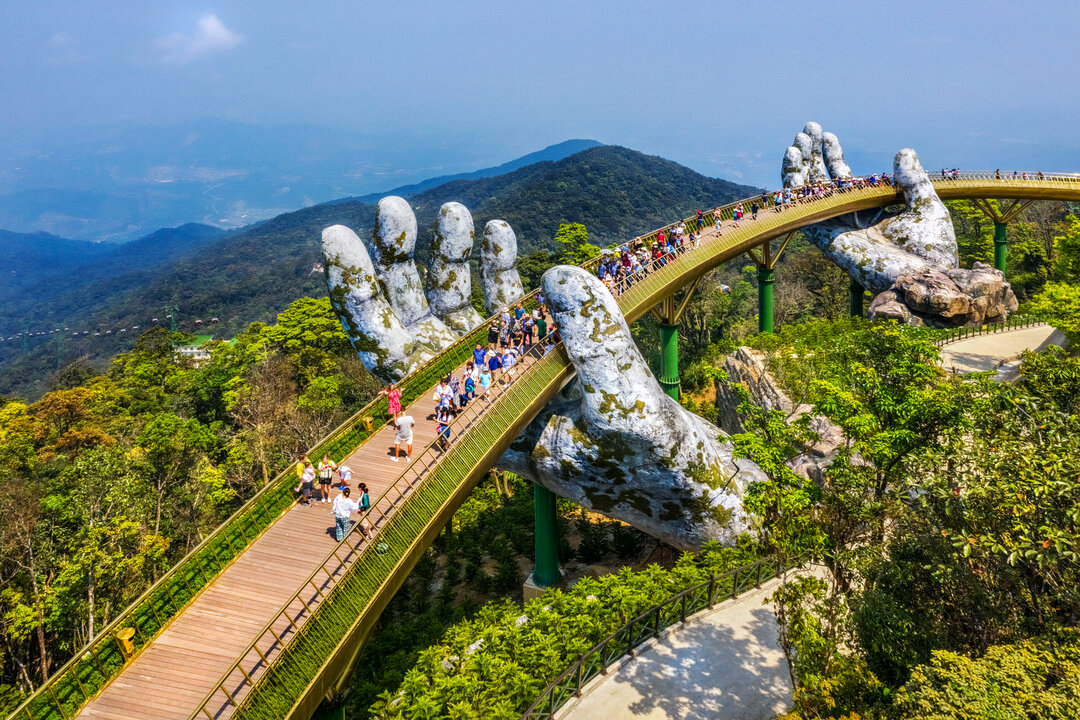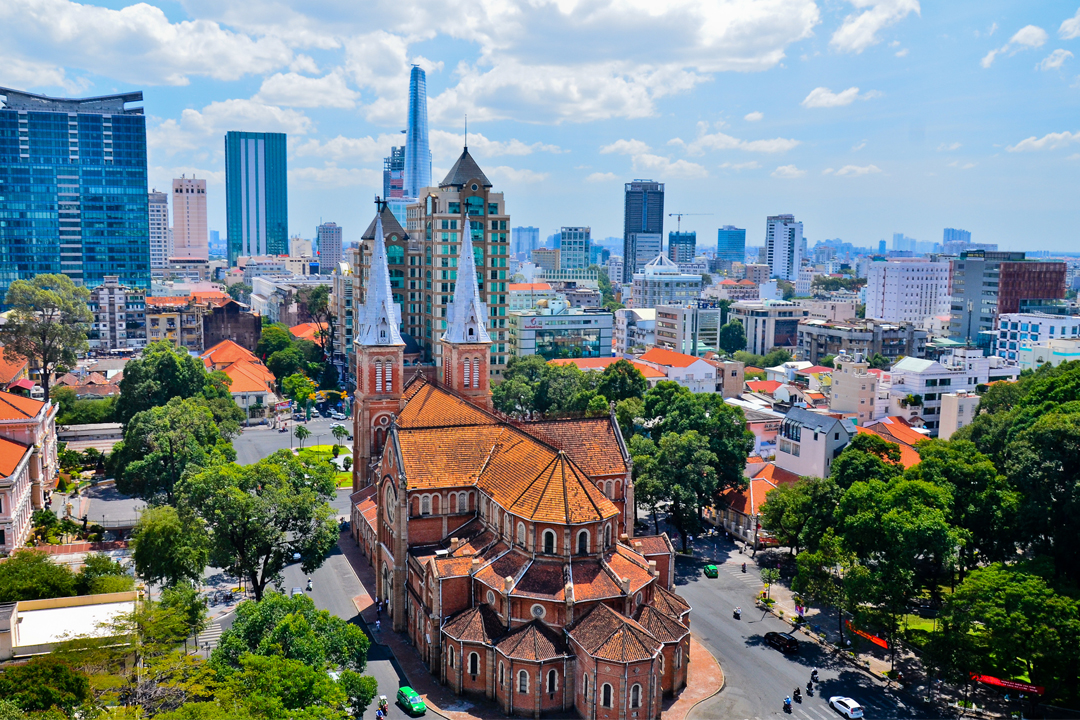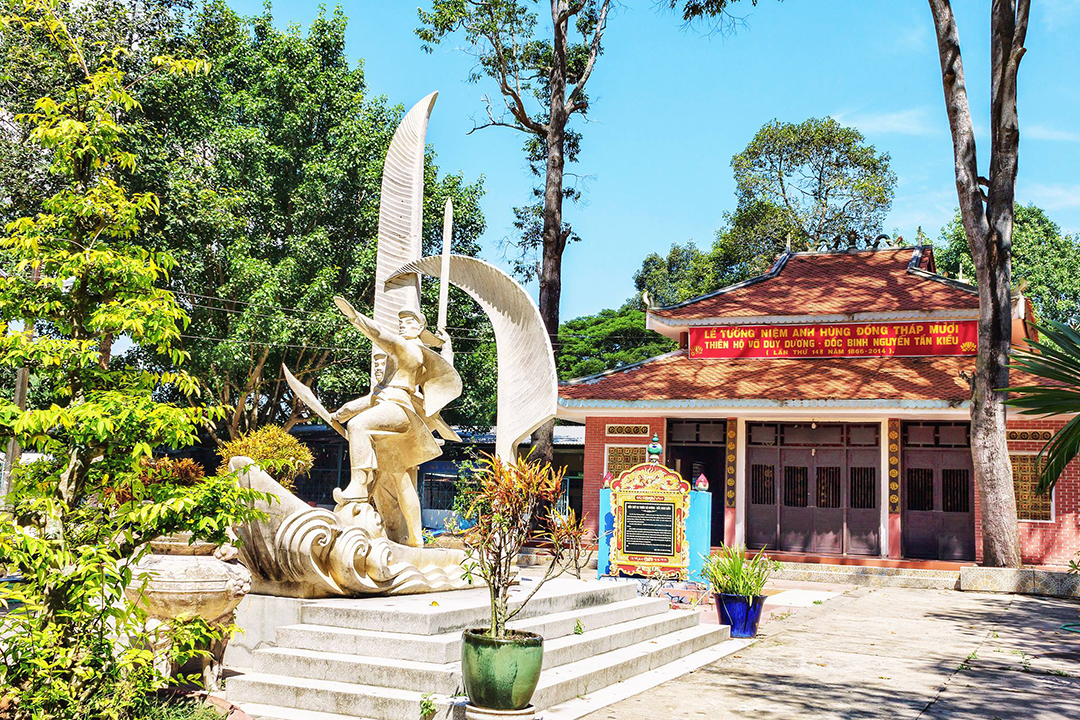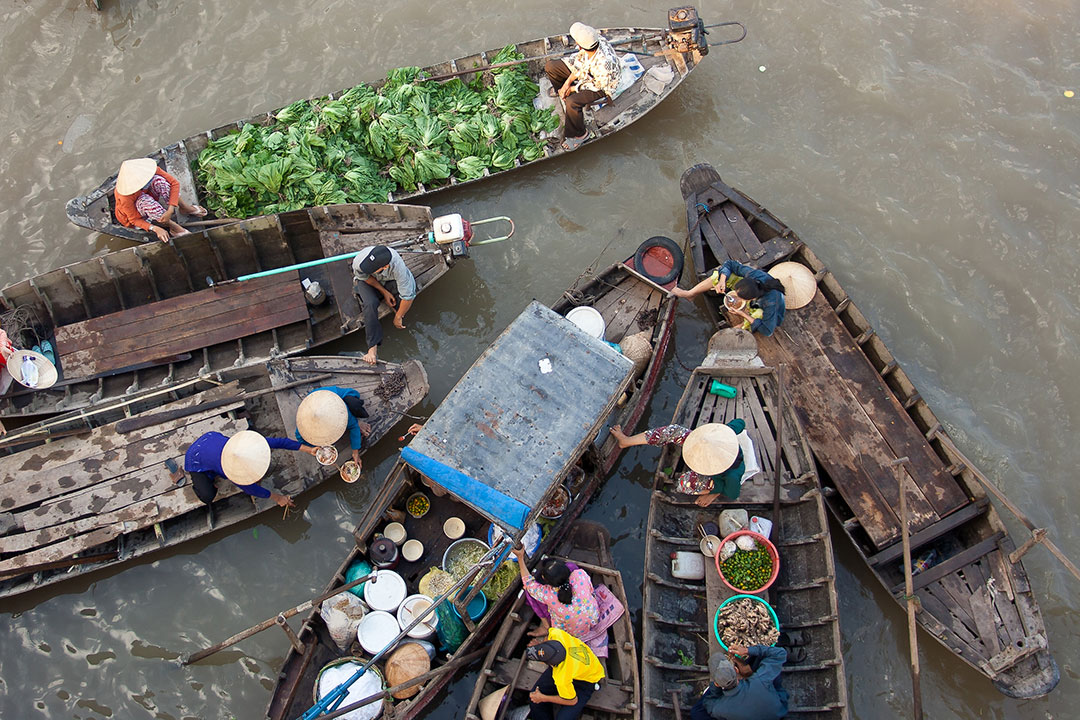Discover Cai Rang Floating Market: History, Things To Do & Travel Guide
Cai Rang Floating Market offers a vivid glimpse into the Mekong Delta's trading culture. Situated about 5.3 km from Can Tho City center, this unique marketplace operates entirely on water, with wooden boats replacing traditional stalls. Vendors sell an array of goods, from fresh produce to household essentials, while some prepare steaming bowls of Vietnamese noodle soup, adding to the lively atmosphere.
The market reaches peak activity before sunrise, with traders arriving as early as 4:00 AM to secure their spots. By 5:00 AM, boats crowd the river, actively exchanging goods as the sun casts its first light over the Mekong Delta. Visitors at this hour can fully immerse themselves in the authentic rhythms of river commerce.
Each boat specializes in specific products, identified by "cay beo" tall poles displaying the items for sale. This visual system eliminates the need for verbal advertisements, making transactions smooth and efficient. Unlike land markets, bargaining is rare, as vendors skillfully maneuver their boats, reflecting the deep-rooted traditions of waterborne trade.
Beyond commerce, Cai Rang Floating Market provides a rich cultural experience. Many boat vendors prepare and serve Mekong delicacies, allowing visitors to savor authentic dishes while drifting along the river. As a vital part of Can Tho’s economy, the market remains a living testament to the enduring heritage of the Mekong Delta.
History and cultural significance of Cai Rang Floating Market
Cai Rang Floating Market's history and culture date back over a century, deeply intertwined with the economic and social fabric of the Mekong Delta. Originating as a crucial trading hub, the market was established to facilitate the exchange of agricultural goods between rural producers and urban buyers. Before modern transportation infrastructure developed, rivers served as the primary highways of the region, making floating markets like Cai Rang essential for commerce. Generations of traders have upheld these traditions, passing down their knowledge and skills in navigating and negotiating on the water.
The cultural significance of the Cai Rang Floating Market extends beyond trade. It embodies the resilient spirit and adaptability of the Mekong Delta’s people. The market showcases a unique barter system where goods are exchanged directly between boats, fostering a strong sense of community among traders. Unlike traditional markets, boats use tall bamboo poles to display goods, allowing silent yet efficient transactions without loud calls or advertisements. This distinctive feature has become an iconic representation of Can Tho river markets, differentiating Cai Rang from land-based marketplaces.
Cai Rang is Can Tho’s largest and busiest river market, drawing both traders and travelers seeking an authentic cultural experience. The market operates as a living museum of the Mekong Delta’s traditions, where visitors can witness age-old customs while engaging with local vendors. Many boats serve as floating homes, further emphasizing the deep-rooted connection between commerce and daily life. This market is a place of trade and a cultural heritage site, preserving the region’s riverine way of life amid modernization.
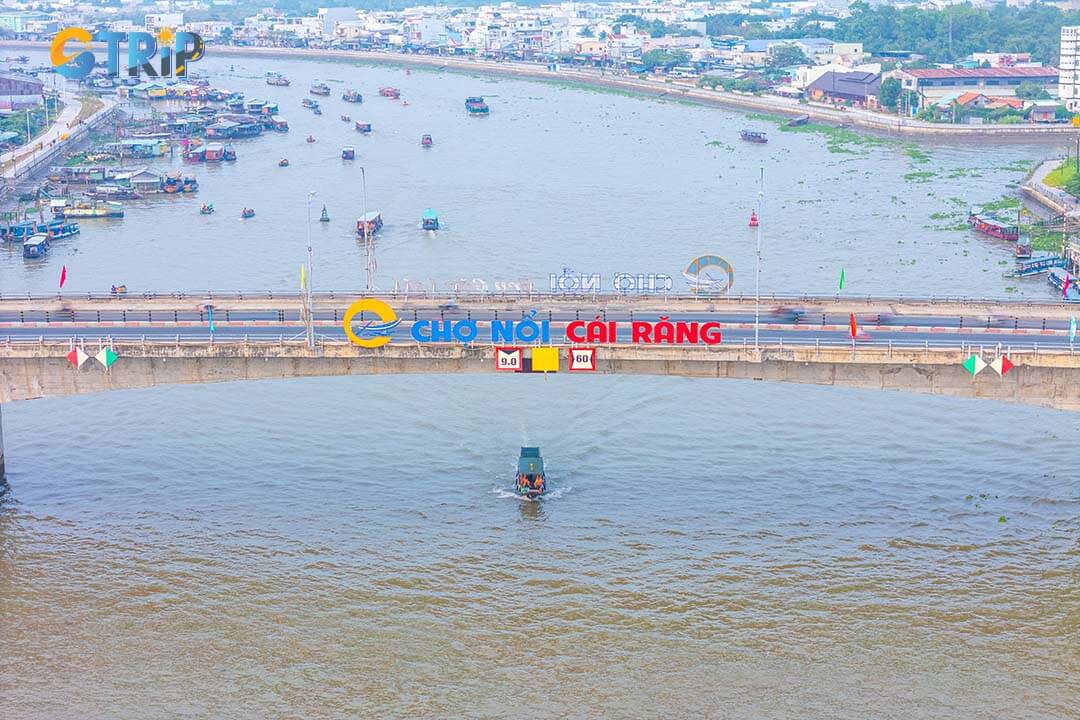
Cai Rang Floating Market is a historic trading hub showcasing the Mekong Delta’s vibrant river culture, resilient traditions, and unique waterborne commerce
When is the best time to visit Cai Rang Floating Market?
The best time to visit Cai Rang Floating Market is in the early morning when the market is at its busiest and most vibrant. By 4:00 AM, traders arrive with boats full of fresh produce, household goods, and local delicacies, setting the stage for the daily floating marketplace. As the sky begins to brighten, the market becomes a lively hub of activity, with merchants skillfully manoeuvring their boats while buyers browse and negotiate prices. The energy peaks between 5:30 AM and 7:00 AM, creating a dynamic scene of commerce and local culture.
Visiting the Cai Rang Floating Market in the early morning also provides a cooler and more comfortable experience. The Mekong Delta’s climate can be hot and humid later in the day, making early morning the most pleasant time to explore. The soft morning light casts a golden glow over the river, creating breathtaking reflections and a picturesque setting for photography. The scent of freshly cooked Vietnamese breakfast dishes, such as hủ tiếu and bún riêu, fills the air as floating vendors prepare steaming bowls of noodles right on their boats.
By 8:00 - 9:00 AM, the market activity begins to slow down as many traders sell out their goods and prepare to leave. While some boats remain, the vibrant energy of the market fades, and the authentic experience diminishes. To fully immerse in the floating market’s charm, it’s best to arrive as early as possible and witness the Mekong Delta waking up to another bustling day of trade and tradition.

The best time to visit Cai Rang Floating Market is early morning, between 5:30 AM and 7:00 AM, when it’s most vibrant
How to get to Cai Rang Floating Market?
Since it is a floating market, the most authentic way to reach it is by water, though there are multiple transportation options available depending on where you start your journey.
From Can Tho City
The most common way to visit Cai Rang Floating Market is by taking a boat from Ninh Kieu Wharf, the central pier of Can Tho. Boats are available for rent as early as 4:00 AM, with options ranging from private wooden boats to shared group tours. A private boat rental allows for a more flexible schedule and a personalized experience, while shared boats are a budget-friendly alternative. The ride from Ninh Kieu Wharf to the market takes approximately 30 - 40 minutes, offering scenic views of the Mekong Delta along the way.
For travelers who prefer to reach the market by land before switching to a boat, taxis and motorbike taxis can take you to Ba Lang Pier, located closer to the market. From Ba Lang, a shorter 10-minute boat ride will get you directly to the heart of the floating market.
From Ho Chi Minh City
For visitors coming from Ho Chi Minh City, the journey to Cai Rang Floating Market requires traveling to Can Tho first. The most convenient options include:
- By bus: Several bus companies operate daily routes between Ho Chi Minh City and Can Tho, with a travel time of 3.5 to 4 hours. Popular companies like Phuong Trang (Futa Bus Lines) and Thanh Buoi offer comfortable sleeper buses with regular departures. Once in Can Tho, you can take a taxi or motorbike taxi to Ninh Kieu Wharf and continue by boat.
- By private car: Hiring a private car provides a more comfortable and flexible journey, especially for groups or families. The drive from Ho Chi Minh City to Can Tho takes approximately 4 - 4.5 hours, depending on traffic conditions.
- By flight: Though Can Tho has an airport (Can Tho International Airport - VCA), flights from Ho Chi Minh City are rare, making road travel the more practical option.
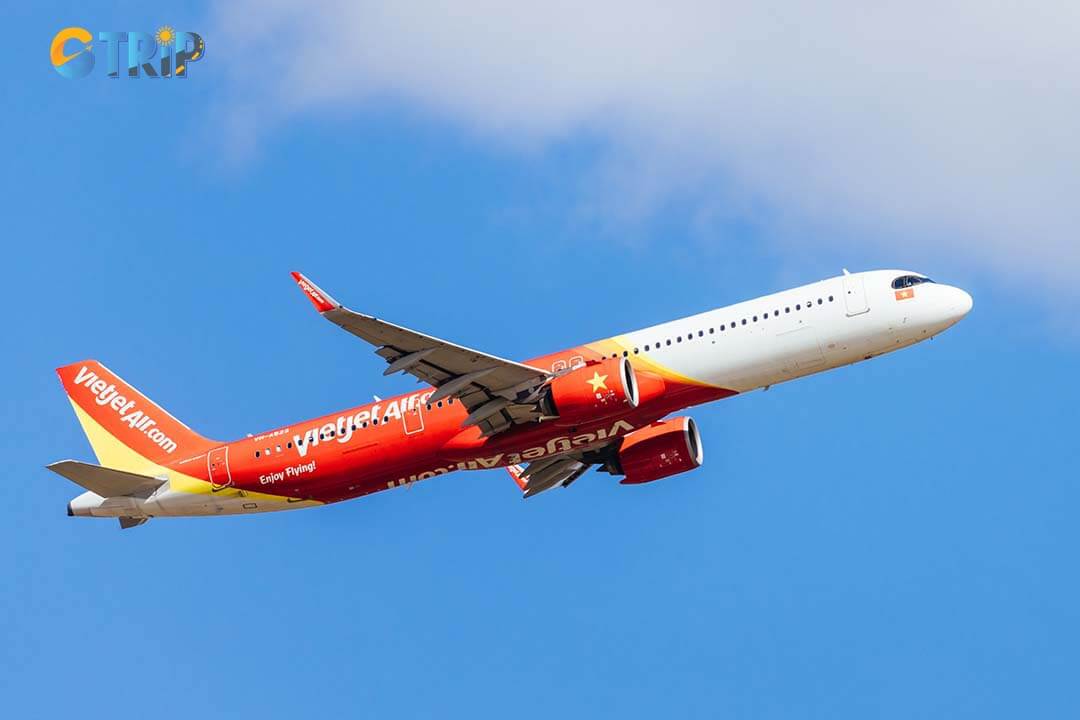
You can fly to Can Tho City if you want to save time on travel
7 things to do in Cai Rang Floating Market
Exploring Cai Rang Floating Market offers a vibrant glimpse into the daily life and culture of the Mekong Delta. A Cai Rang Floating Market tour provides unique experiences that range from tasting local dishes to observing traditional trade practices. Here are seven must-do activities that capture the essence of this iconic market:
1. Experience boat-to-boat sales of local fruits and vegetables
Wake up early to witness the dynamic boat-to-boat sales that define the market. Vendors navigate narrow wooden boats filled with fresh fruits like mangoes, pineapples, and dragon fruits. Each boat displays a long pole with samples of its goods, making it easy to identify products from a distance. The lively exchanges between sellers and buyers reflect the region’s close-knit community and rich agricultural heritage.
You can observe the traditional bargaining methods as sellers call out their offerings while steering their boats with long oars. The market's authenticity lies in this age-old practice, where fruits and vegetables are sold in bulk to both local buyers and visitors. Large boats serve as mobile wholesale markets, while smaller boats act as retail vendors, creating a layered ecosystem of trade unique to the Mekong Delta.

Wake up early to experience the bustling boat-to-boat trade, where vendors display fresh fruits on long poles and navigate the river
2. Taste traditional Vietnamese breakfast on floating boats
Enjoy an authentic Vietnamese breakfast served right on the water. Vendors prepare dishes like pho, banh mi, and bun rieu from compact kitchens on their boats. The aroma of broth and grilled meats blends with the cool morning air, creating a sensory experience that’s both delicious and memorable. Don’t miss the chance to try local food at Cai Rang Floating Market, including sticky rice and fresh coconut juice.
Imagine sitting on a wooden boat, savoring a steaming bowl of pho while watching the sunrise over the river. Some boats specialize in banh tam bi (thick rice noodles with coconut cream) and hu tieu (rice noodle soup with pork), showcasing the diverse culinary heritage of southern Vietnam. Vendors skillfully balance cooking equipment and ingredients in limited space, offering quick yet flavorful meals.
3. Capture photos of boat vendors' interactions during the early morning hours
Photography enthusiasts will find endless opportunities to capture the market’s vibrant atmosphere. The golden morning light reflects off the water, highlighting the colorful boats and bustling vendors. Candid shots of merchants exchanging goods, steaming bowls of noodles, and fruit-laden boats make for compelling photographs that tell the story of daily life in the Mekong Delta.
Early morning is the best time for photography, as the soft light enhances the vivid colors of fruits, textiles, and traditional wooden boats. The constant movement of boats creates dynamic compositions, while interactions between sellers and buyers add human elements to your shots. Consider using a telephoto lens to capture close-up expressions without disturbing the natural flow of activities.
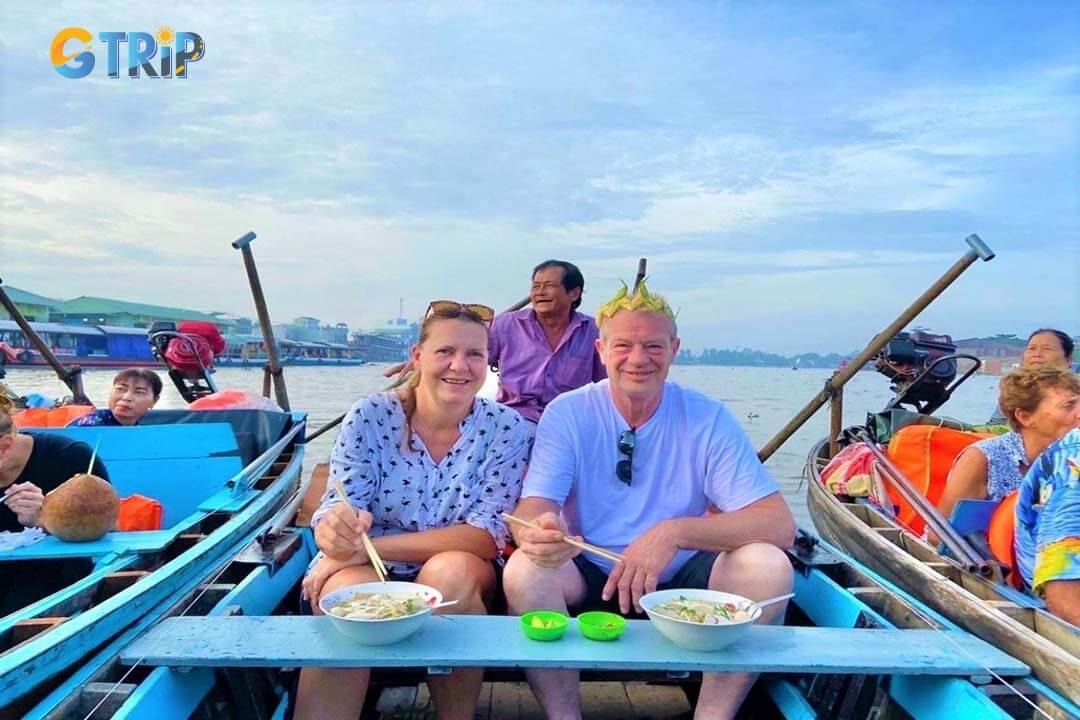
Savor an authentic Vietnamese breakfast on the water, from steaming pho to banh mi, as vendors cook aboard their boats, blending rich aromas with the cool morning air
4. Take a guided floating market tour along the Mekong River
A guided tour offers insights into the market’s history and significance within the local economy. Knowledgeable guides share stories about the region’s culture and trading practices while navigating through narrow waterways. Tours often include visits to nearby attractions, such as traditional villages and craft workshops, enhancing the overall experience. Explore more along the Mekong Delta through curated itineraries available at the Vietnam Tours Package of GTrip. The guides also explain the market’s structure, where larger boats anchor in specific areas to sell wholesale goods, while smaller boats move freely to sell directly to consumers. Some tours include stops at family-owned businesses, offering an authentic look at local livelihoods.
5. Explore rice noodle production near the market
You can visit rice noodle production facilities near the market. Watch skilled artisans transform rice flour into thin, translucent noodles used in Vietnamese cuisine. The process involves steaming, drying, and cutting the noodles by hand, offering a deeper appreciation for the craftsmanship behind everyday dishes like pho and bun rieu. Visitors can witness each step of the process, from soaking rice to grinding it into a smooth paste, which is then spread into thin sheets and steamed. The dried sheets are cut into noodles of varying thickness, depending on their intended use. Some facilities allow visitors to sample freshly made noodles, highlighting their delicate texture and subtle flavor. This experience provides valuable insight into the labor-intensive methods that sustain the region’s culinary traditions.
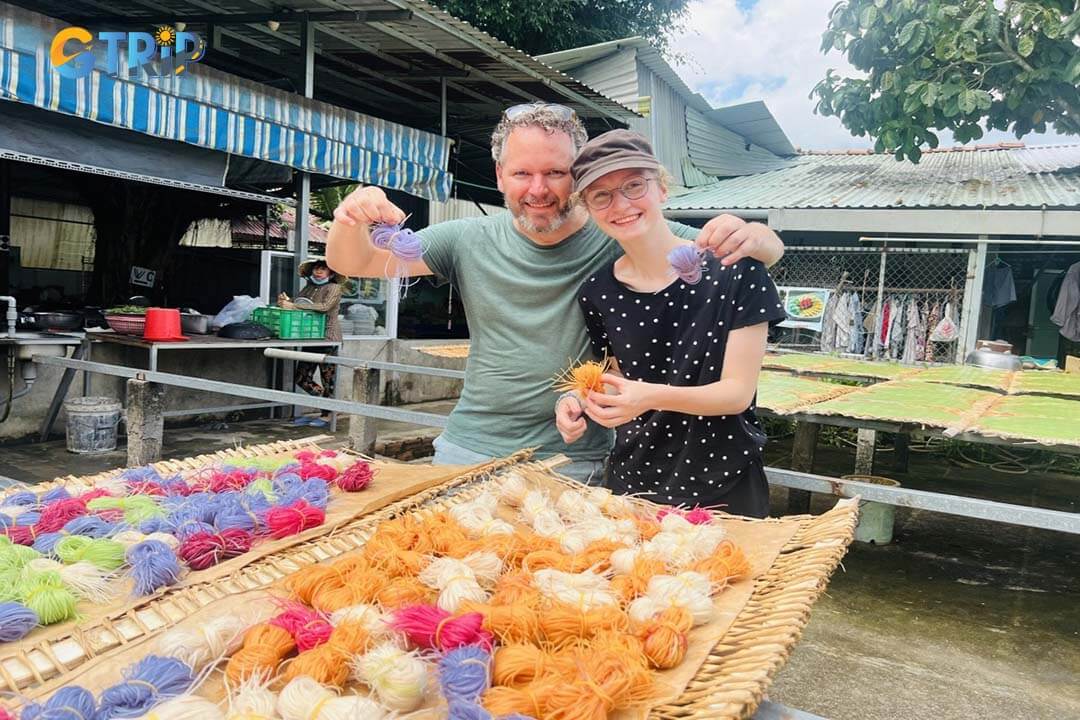
Visit rice noodle workshops near the market to see artisans craft delicate noodles through steaming, drying, and hand-cutting, offering insight into Vietnam’s traditions
6. Buy traditional Vietnamese goods directly from local sellers
Support the local economy by purchasing traditional goods directly from vendors. Handwoven baskets, bamboo crafts, and coconut candy are popular souvenirs that showcase the region’s artisanal heritage. The market also offers fresh spices, dried fruits, and handmade textiles, providing authentic mementos for your visit. This is where the search for what to buy at Cai Rang Floating Market truly comes to life. Vendors often display their products on wooden platforms built onto their boats, making it easy for customers to browse and purchase items without leaving their boats. The direct interaction with sellers offers a more personal shopping experience, allowing visitors to learn about the origins and uses of each item. Traditional conical hats, woven from palm leaves, are both practical souvenirs and symbols of Vietnamese culture. Additionally, fresh spices like star anise and cinnamon make excellent gifts for culinary enthusiasts.
7. Enjoy Vietnamese street food while observing Mekong Delta culture
End your visit with a taste of Vietnamese street food, freshly prepared on the boats. From grilled seafood and spring rolls to sticky rice cakes, the market offers a variety of local delicacies. Some boats specialize in signature dishes like grilled squid skewers with chili and salt or banh xeo, crispy rice pancakes filled with shrimp and bean sprouts. For those with a sweet tooth, treats such as banh chuoi (steamed banana cake) and che (sweet soups) showcase traditional Vietnamese desserts. A unique highlight is the beautifully crafted mung bean cakes, shaped like Southern fruits with a glossy finish. Amid the lively atmosphere, vendors share meals and conversations, reflecting the strong sense of community that defines life in the Mekong Delta.
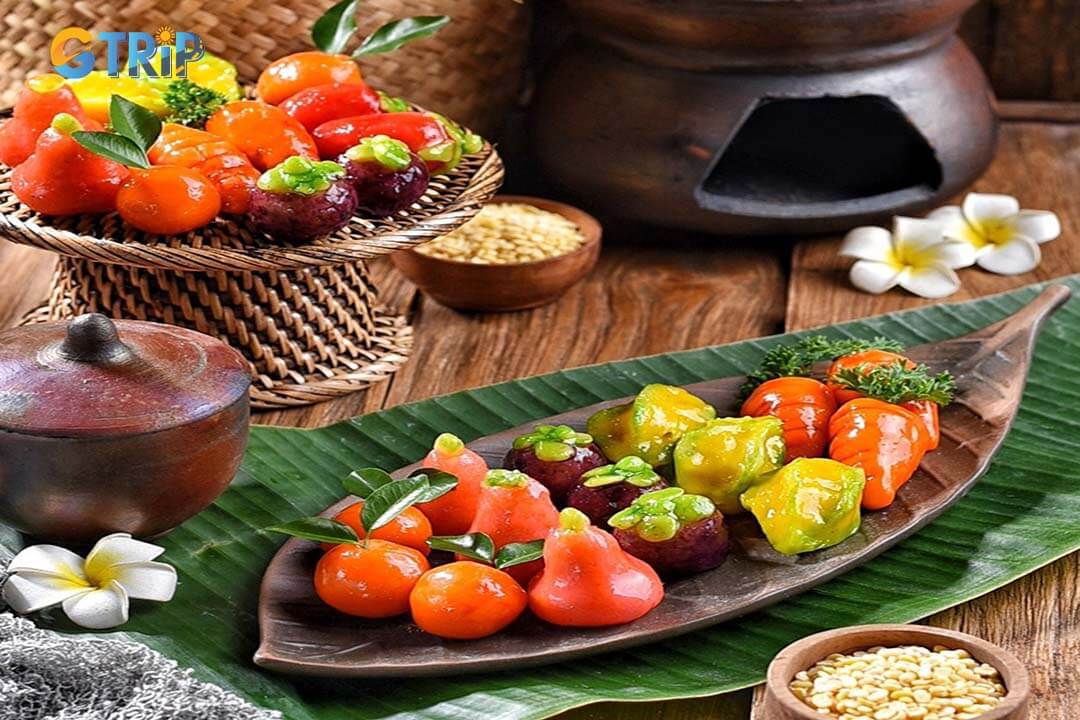
A unique highlight is the beautifully crafted mung bean cakes, shaped like fruits with a glossy finish
Local specialties and must-try foods
Experiencing the vibrant atmosphere of Cai Rang Floating Market wouldn't be complete without indulging in its local cuisine at Cai Rang Floating Market. Boats in the Mekong Delta serve fresh, authentic dishes, showcasing the region's rich culinary heritage.
Fresh tropical fruits
One of the most sought-after products at Cai Rang Floating Market is its impressive variety of local food at Cai Rang Floating Market, particularly the abundance of tropical fruits. Vendors pile their boats high with freshly harvested produce, from juicy mangoes and creamy durians to fragrant rambutans and dragon fruits. The best part? You can sample these fruits directly from the vendors or enjoy a freshly blended fruit smoothie right on the water.
Vietnamese rice noodle soup (Hu Tieu)
For an authentic local breakfast, nothing beats a steaming bowl of hu tieu, a flavorful noodle soup that is a staple of what to buy at Cai Rang Floating Market. Cooked right on small boats, this dish features a savory broth, tender rice noodles, and a variety of toppings such as pork, shrimp, and fresh herbs. Vendors typically add a squeeze of lime and some chilli to enhance the flavors, creating a perfect balance of taste.
Grilled seafood
Given its location along the Mekong River, Cai Rang Floating Market is an excellent place to enjoy grilled seafood. Vendors prepare freshly caught fish, shrimp, suckermouth catfish and over open flames, often marinated with local spices and served with a tangy dipping sauce. The aroma alone is enough to entice visitors to try these flavorful dishes while cruising through the market.
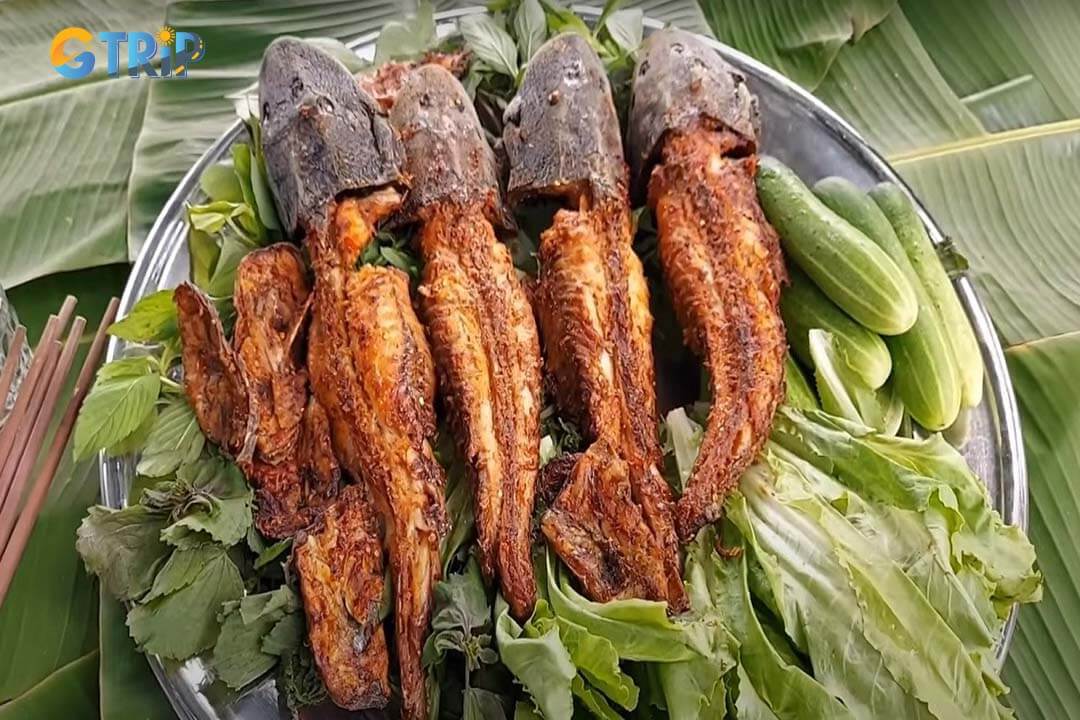
Cai Rang Floating Market offers freshly grilled seafood, marinated with local spices and served with tangy dipping sauce for a flavorful Mekong experience
Bread and Mekong-style coffee
Besides full meals, the market offers delicious street food, such as banh mi. This crispy baguette sandwich is filled with savory meats, tangy pickled vegetables, and fragrant herbs. To complete your meal, enjoy a cup of Mekong-style coffee. It is brewed using a traditional drip filter and served with creamy condensed milk, creating a bold, smooth, and sweet flavor.
Nearby attractions to explore in Can Tho
Exploring nearby attractions in Can Tho after visiting Cai Rang Floating Market offers travelers a deeper insight into the cultural and historical richness of the Mekong Delta. The city is home to fascinating landmarks, tranquil riverside spots, and well-preserved colonial architecture. It makes a must-visit destination beyond the floating market experience.
Binh Thuy Ancient House
One of the most iconic cultural sites in Can Tho, Binh Thuy Ancient House is a beautifully preserved French style. Built in 1870, this house showcases a unique blend of Vietnamese, French, and Chinese architectural influences, featuring intricate wood carvings, antique furniture, and spacious courtyards. It is also famous for being the filming location of the renowned French movie The Lover. Visitors interested in history and architecture will find this heritage site a fascinating stop on their journey.
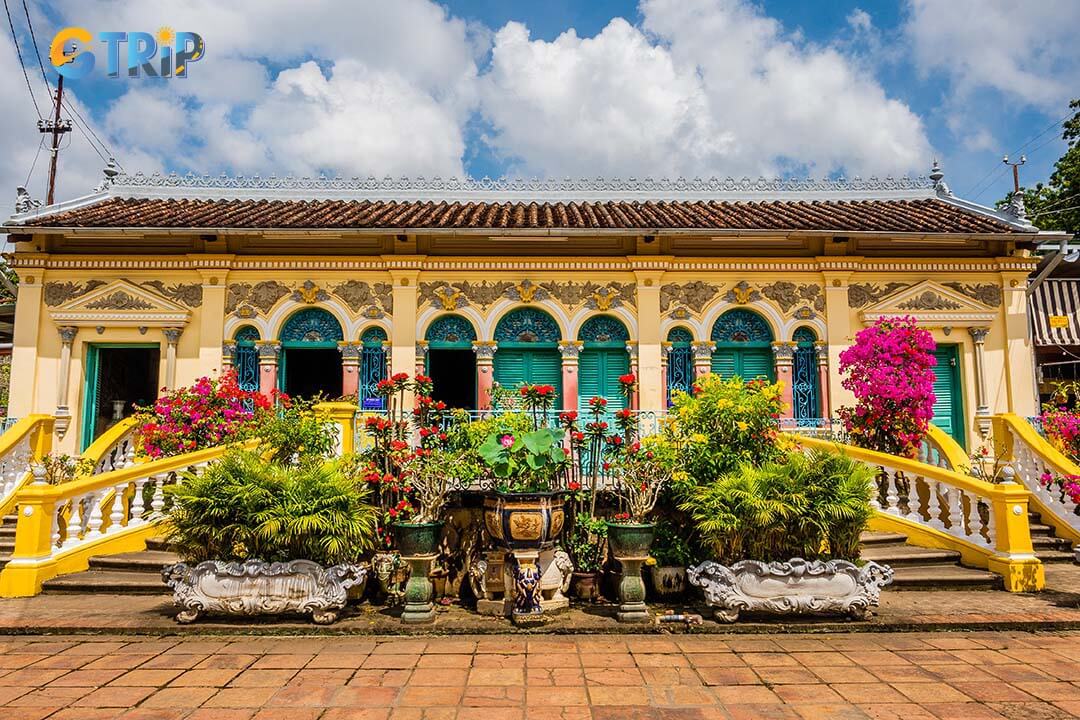
Binh Thuy Ancient House, a well-preserved 19th-century mansion, showcases a blend of Vietnamese, French, and Chinese architecture
Ninh Kieu Wharf
Located along the Hau River, Ninh Kieu Wharf is a lively waterfront area that serves as the cultural and commercial hub of Can Tho. The wharf is known for its scenic promenade, illuminated bridges, and floating restaurants that offer stunning views of the river. A stroll along Ninh Kieu Park in the evening provides a chance to experience the local nightlife, with street performances, food vendors, and traditional boat rides. For those wanting to explore more of the Mekong Delta, Ninh Kieu Wharf is the main departure point for boat tours. It including full-day experiences like the Mekong Delta exploration in one day, which includes visits to floating markets, local villages, and fruit orchards.
Ong Pagoda
Just a short walk from Ninh Kieu Wharf, Ong Pagoda stands as one of Can Tho’s most significant religious sites. Built in the late 19th century by the Chinese community, this pagoda is dedicated to Quan Cong, a symbol of loyalty and righteousness in Chinese folklore. The pagoda’s vibrant red lanterns, intricate carvings, and fragrant incense-filled halls create a deeply spiritual atmosphere. Whether you seek a moment of tranquility or wish to admire the pagoda’s artistic details, a visit here provides a deeper understanding of Can Tho’s multicultural heritage.
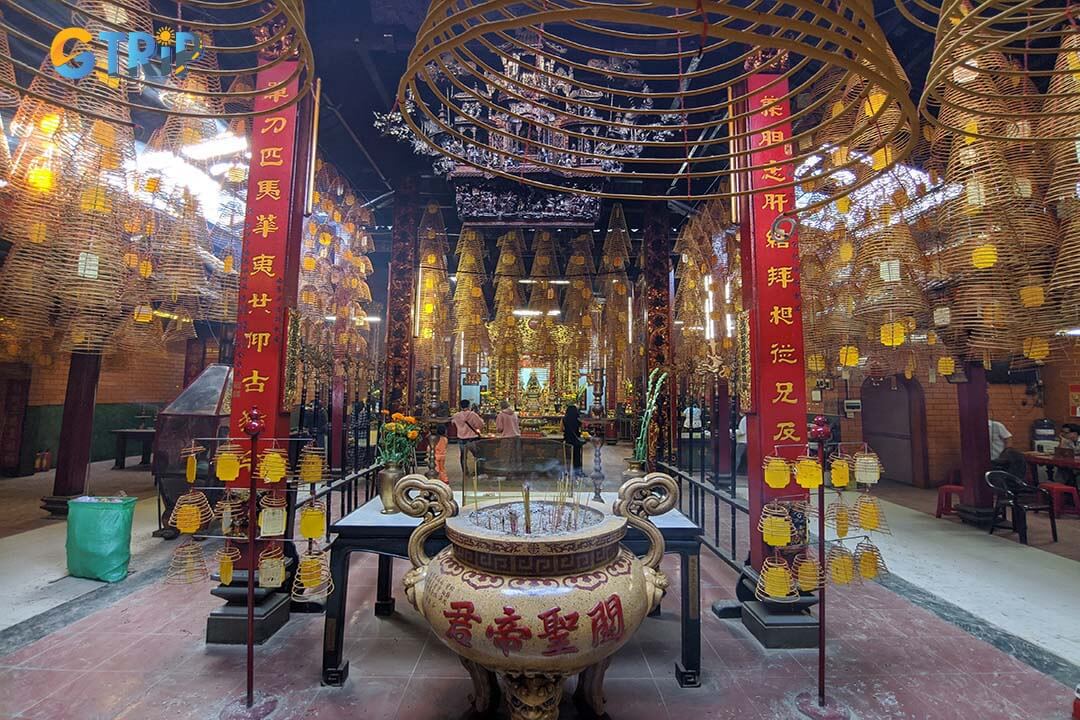
Ong Pagoda showcases Chinese heritage with vibrant lanterns, intricate carvings, and a deeply spiritual atmosphere
Frequently asked questions when visiting Cai Rang Floating Market
Cai Rang Floating Market, the largest in Vietnam, offers a vibrant glimpse into Mekong Delta life. Just a short boat ride from Can Tho, it comes alive at dawn with boats trading fresh produce, local dishes, and household goods. More than a market, it’s a cultural experience where visitors can savor Mekong cuisine, interact with vendors, and explore river life.
How much does a boat tour cost?
The Cai Rang Floating Market tour booking prices vary depending on the type of boat and tour experience you choose:
- Shared boat tours: Starting from 150,000 - 200,000 VND ($6 - $8) per person, these are affordable options where visitors join a group.
- Private boat rentals: Costs range from 500,000 - 1,000,000 VND ($20 - $40) depending on the boat size and duration of the trip.
- Guided tours with meals: Some tours include breakfast and additional sightseeing, priced between 700,000 - 1,500,000 VND ($27.57 - $60) per person.
Is it possible to visit the Cai Rang Floating Market without a tour?
Yes, you can explore the Cai Rang Floating Market without a guided tour by renting a boat directly at Ninh Kieu Wharf. Independent boat rentals are available for both solo travelers and small groups, and costs typically start from 250,000 VND ($10) for a basic trip.
What special souvenirs can I buy in Can Tho?
In Can Tho, visitors can find unique souvenirs that reflect the vibrant culture of the Mekong Delta. Popular choices include dried fruits and coconut candies, which are locally made and packed for easy transport. Handwoven bamboo and rattan products, such as baskets and mats, showcase traditional craftsmanship. Rice paper and fermented fish sauce are great options for food lovers who want to bring home the flavors of the region. Additionally, handcrafted wooden boats and miniature floating market models serve as charming reminders of a trip to Cai Rang Floating Market.
Cai Rang Floating Market offers a dynamic glimpse into the Mekong Delta’s trading culture. Where boats brimming with fresh produce, local delicacies, and handcrafted goods create a lively scene at dawn. From exploring the history and cultural significance of the market to indulging in authentic Mekong cuisine, visitors can immerse themselves in an experience that blends tradition with daily life. Whether arriving by private boat or joining a guided tour, the market’s energy is best felt early in the morning, when traders actively engage in commerce.
For those looking to discover more of the region, Can Tho’s nearby attractions offer additional opportunities to explore its rich heritage. If you're planning a deeper journey through the Mekong Delta, check out Mekong Delta Tours by GTrip - Vietnam Travel Agency. We provide curated itineraries that highlight the best of Southern Vietnam’s waterways and cultural landmarks.

